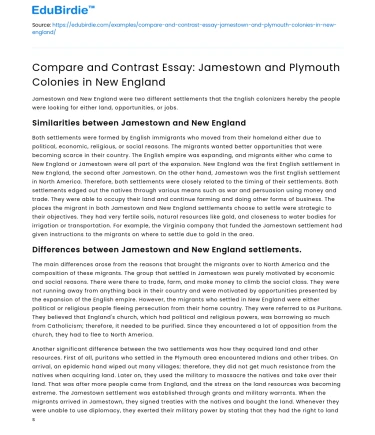Jamestown and New England were two different settlements that the English colonizers hereby the people were looking for either land, opportunities, or jobs.
Similarities between Jamestown and New England
Both settlements were formed by English immigrants who moved from their homeland either due to political, economic, religious, or social reasons. The migrants wanted better opportunities that were becoming scarce in their country. The English empire was expanding, and migrants either who came to New England or Jamestown were all part of the expansion. New England was the first English settlement in New England, the second after Jamestown. On the other hand, Jamestown was the first English settlement in North America. Therefore, both settlements were closely related to the timing of their settlements. Both settlements edged out the natives through various means such as war and persuasion using money and trade. They were able to occupy their land and continue farming and doing other forms of business. The places the migrant in both Jamestown and New England settlements choose to settle were strategic to their objectives. They had very fertile soils, natural resources like gold, and closeness to water bodies for irrigation or transportation. For example, the Virginia company that funded the Jamestown settlement had given instructions to the migrants on where to settle due to gold in the area.
Save your time!
We can take care of your essay
- Proper editing and formatting
- Free revision, title page, and bibliography
- Flexible prices and money-back guarantee
Differences between Jamestown and New England settlements.
The main differences arose from the reasons that brought the migrants over to North America and the composition of these migrants. The group that settled in Jamestown was purely motivated by economic and social reasons. There were there to trade, farm, and make money to climb the social class. They were not running away from anything back in their country and were motivated by opportunities presented by the expansion of the English empire. However, the migrants who settled in New England were either political or religious people fleeing persecution from their home country. They were referred to as Puritans. They believed that England's church, which had political and religious powers, was borrowing so much from Catholicism; therefore, it needed to be purified. Since they encountered a lot of opposition from the church, they had to flee to North America.
Another significant difference between the two settlements was how they acquired land and other resources. First of all, puritans who settled in the Plymouth area encountered Indians and other tribes. On arrival, an epidemic hand wiped out many villages; therefore, they did not get much resistance from the natives when acquiring land. Later on, they used the military to massacre the natives and take over their land. That was after more people came from England, and the stress on the land resources was becoming extreme. The Jamestown settlement was established through grants and military warrants. When the migrants arrived in Jamestown, they signed treaties with the natives and bought the land. Whenever they were unable to use diplomacy, they exerted their military power by stating that they had the right to land since they fought in the military. But generally, they bought the land. The Puritans also settled in an area where most natives moved during the winter to the new settlement and returned when the conditions were favorable. When they moved out, the Puritans would move into their lands.






 Stuck on your essay?
Stuck on your essay?

